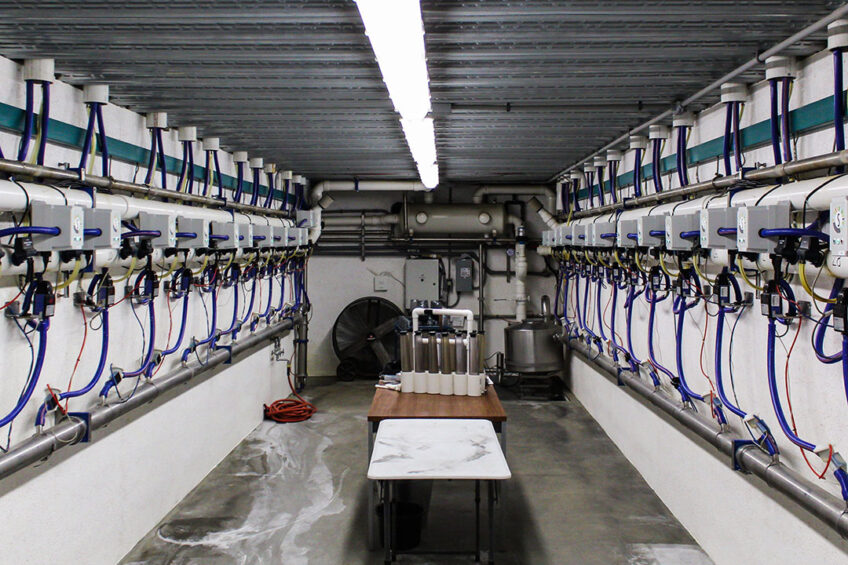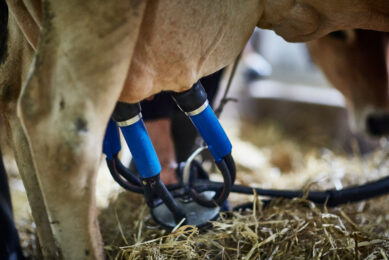Milk analysis: Real-time technologies for better herd health

In the case of dairy farmers, very rapid or real-time milk analysis technologies are now enabling the health (and therefore the milk quality) of individual cows to be continuously optimised. We look at 3 milk analysis technologies.
Increasing numbers of those across agriculture and many other industries are benefiting from data provided very rapidly or in real time. In any system, if a problem – or the precursor of a problem – can be immediately detected, swift actions can be taken before productivity or quality are lowered very much or at all.
The main health issue that dairy farmers want to detect is mastitis. In their presentation at the 18th International Scientific Conference Engineering for Rural Development in May 2019, Ivars Lusis, Armins Laurs and Vita Antane of the Latvia University of Agriculture note that for detection of subclinical mastitis, somatic cell count (SCC) is the most commonly-used indicator worldwide. “Milk with a high SCC,” they state, “indicates a cow with udder health problems which can be clinical or subclinical.”
These scientists analysed the performance of automated measurement of whole milk SCC by the ‘viscosity method’ in robotic milking systems, and found the method “objective, informative, and has relatively low costs” for the evaluation of cow udder health status.
Ekomilk
The viscosity method of measuring SCC is used in the Ekomilk Horizon UNLIMITED milk analyzer marketed by Bulgaria-based Ekomilk. The machine also provides ultrasound measurement of milk composition parameters like fat, protein, solids not fat, density, conductivity and lactose. Samples are placed in the machine on the farm or sent to a central testing site, and results are automatically transferred to the systems’ online platform, which can be accessed by customers anywhere internet service is available.

The system was developed in 2015 and demonstrated on farms in 2016, with one project receiving the ‘Seal of Excellence Award’ from the European Commission. Along the way, the technology was evaluated on about a hundred farms worldwide in 14 countries within Europe, the Middle East and Asia. “Some evaluator-users are farms with milking robots with about 120 cows, and other users are labs attached to very large farms with over 1,000 cows,” explains Evelina Pashova of the Ekomilk marketing and sales department. “Veterinarians and pharmaceutical companies also cover another cluster.”
Since late 2018, the system has been for sale in 30 countries. Milk can be analysed from the bulk tank, individual cows or individual udder quarters, says Pashova. “Also, labs and veterinarians requiring high sample throughput (over 2000 milk samples per day) will have an affordable solution at approximately €0.03/test.” The test takes about one minute.
The company is now introducing a version of Ekomilk Horizon UNLIMITED which provides simple connection to major brands of robotic milkers to provide real-time milk analysis. Furthermore, explains Pashova, the technology is being developed to incorporate artificial intelligence into the online platform, allowing “faster real-time planning of equipment intervention and also for improving and automating calibrations such as calibration for ketosis risk indication, protein, fats and SCC. Finally, application programming interfaces will be developed to facilitate data exchange with other players such as the Dairy Herd Improvement Association in the US, milk processors and veterinarians. Testing of milk fractions is also being explored together with large industrial partners.”
GEA
GEA’s DairyMilk M6850 is another milk analysis system, one that can analyse each udder quarter individually. It is the industry’s first automated SCC measurement system that continuously analyses milk flow from each individual quarter throughout the entire milking process, and if a high SCC count in the milk of one quarter is detected, an alarm goes off.
The system measures SCC with a patented technology called EPT (Electrical Permittivity Threshold) and no further details can be provided as they are proprietary. It was introduced for automatic milking systems worldwide during EuroTier 2018 in Germany after extensive testing, says spokesperson Lilian Schmalenstroer.
SomaDetect
The milk analysis of technology of SomaDetect, a company started in Canada in 2016, is not yet commercially available, but is being tested on six farms in Canada (in Ontario and British Columbia) and the US (in New York and Minnesota). “At this stage, our farmers have not been using SomaDetect data for decision-making, though we are incredibly excited to be kicking this off in the coming months,” says CEO Dr Bethany Deshpande.

She and her team are also very excited about the preliminary results of pilot projects and are preparing to share early data with early-adopter farms in the near future. “Our anticipated commercialisation was expected in 2020, but we are adjusting as this [pandemic] situation unfolds,” says Deshpande.
The technology involves the projection of a beam of light through the milk, which, as it collides with particles of fat and protein, creates a scattering pattern detected by a sensor. Collisions with particles of different sizes, in various concentrations – such as somatic cells – create different scattering patterns that are compared by the software to baselines.

It was developed by Deshpande’s father, Dr Satish Deshpande. Years ago at his firm SpectraDigital in Ontario, he was developing a simple and economical light-scattering sensor that could identify agents in the blood that cause diseases like malaria and tuberculosis. He realised in 2014 that he also had a reliable way on his hands to instantly determine components of milk. A patent for SCC detection in milk followed.
The SomaDetect sensor is enclosed in a box that’s attached to the milking hose, and the data collected by the sensor is analysed by the system’s software and presented to farmers on a web-based platform. In 2018, SomaDetect moved from Canada to Buffalo, New York as part of the acceptance of a $1million grand prize from a state-sponsored contest for start-ups. In April of that year, SomaDetect began a research partnership with Cornell University to validate and further develop the tech. In February 2020, the company entered a partnership with major dairy management software provider, Valley Agricultural Software.
Join 13,000+ subscribers
Subscribe to our newsletter to stay updated about all the need-to-know content in the dairy sector, two times a week.










